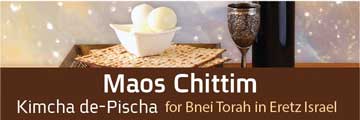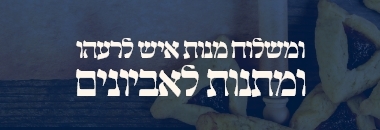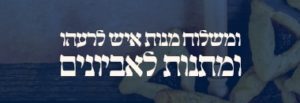The Midrash (Tanchuma 2) makes a connection between the beginning of Parashas Korach, and the end of Parashas Shelach which discusses the mitzvah of tzitzis:
“What is written prior to this passage? – ‘Speak to Children of Israel and say to them that they shall make themselves tzitzis‘ (Bamidbar 15:38). Korach jumped up and said to Moshe: You say, ‘They shall place upon the tzitzis.’ A tallis that is completely techeiles – is it exempt from tzitzis? Moshe responded: It requires tzitzis. Korach said: A tallis that is completely techeiles cannot exempt itself, yet four threads exempt it?!”
In last week’s article we focused on the basic obligation of tzitzis for various garments and the laws of wearing them. This week, we will focus our attention on the mitzvah of techeiles.
The Blue Dye of Techeiles
The Torah teaches that a person must place a thread of techeiles in the tzitzis tassels that are affixed to four-cornered garments (Bamidbar 15:39). For more than a hundred years the debate over identifying the true techeiles has been at the fore of the Torah world, and in recent times more and more people are starting to wear the blue string as part of their tzitzis.
By way of introduction, we will outline the historical development of this research, together with the practical ramifications, until today.
The Gemara teaches that the source for techeiles – a blue dye – is a marine creature known as the chilazon, which translates as “snail” in Modern Hebrew. The Gemara also mentions a counterfeit dye from a plant called kela-ilan, known as indigofera tinctoria, the common source of blue dye in the ancient world.
The equivalence of color between these two sources indicates that techeiles is, indeed, a blue hue. The Gemara writes that the color of the techeiles thread is similar to the sea, suggesting again a blue color, and a broad consensus of early authorities agrees that the color of techeiles is blue.
Beyond this, however, the identity of the chilazon from which the dye is extracted was lost at some point after the Roman exile of the Jews from the Land of Israel. It is clear that in Talmudic times, the techeiles dye was still in use; at some stage, it was lost.
Identifying the Techeiles Chilazon
In 1887, Rabbi Gershon Henoch Leiner, the Radziner Rebbe, researched the subject, trying to identify the chilazon species based on criteria mentioned in the Gemara and other writings of the Sages. His conclusion was that the sepia officinalis (common cuttlefish) met many of the criteria, and within a year Radziner chassidim began wearing tzitzis dyed with a color produced from this species. [Some Breslov Hasidim also adopted this custom, and continue to use this form of techeiles to this day.]
Rabbi Yitzhak Ha-Levi Herzog (1889–1959) rejected this identification, after showing, by means of chemical analysis, that the resulting dye was just a well-known synthetic dye called “Prussian blue.” The dye is made by reacting iron sulfate with an organic material, in this case supplied by the cuttlefish.
Within his doctoral research on the subject of techeiles, Rabbi Herzog placed great hopes on demonstrating that the Murex trunculus was the genuine snail chilazon. However, Rabbi Herzog failed to consistently achieve blue dye from the Murex trunculus, and therefore gave up on this identification, suggesting an alternative: “If for the present all hope is to be abandoned of rediscovering the hillazon shel techeiles in some species of the genera Murex and Purpura, we could do worse than suggest the Janthina as a not improbable identification.”
In present times, however, the Murex trunculus (a sea snail also known as the Hexaplex trunculus, which is known to have been a common source of blue dye in the ancient world) has returned as the primary candidate for identification with the techeiles chilazon.
The Murex, as Rabbi Herzog pointed out, fulfills many of the Talmudic criteria, and Rabbi Herzog only rejected it on account of his inability to consistently obtain blue dye (sometimes the dye was purple) from the snail. In the 1980s, Otto Elsner, a chemist from the Shenkar College of Fibers in Israel, discovered that if a solution of the dye was exposed to sunlight, blue instead of purple was consistently produced.
In 1988 Rabbi Eliyahu Tavger dyed techeiles from Murex trunculus for the mitzvah (commandment) of tzitzis for the first time in over 1300 years. Based on his work, four years later the Ptil Techeiles Organization was founded to educate about the dye production process and to make the dye available for all who desire to use it.
It is important to note that Rabbi Herzog was not the first to suggest the Murex as the historical source of techeiles. The suggestion already appears in the writings of Rabbi Yair Chaim Bachrach, the renowned Chavas Yair (1638-1702), who writes (in his Mekor Chaim, Orach Chaim I:99) that the blue dye of techeiles is porphura, a word meaning “purple fish” in ancient Greek, and referring to the Murex. In academic research, the identification of techeiles with the Murex also predates the findings of Rabbi Herzog (see Ha-Techeiles p. 418-9).
Today, there are several rabbinic figures who support the use of techeiles as produced from the Murex, and many indeed have begun to tie a techeiles string in their tzitzis. Other rabbis remain unconvinced, and have declared that there is no obligation to affix the techeiles thread to tzitzis.
In the present article we will not enter the debate whether the Murex is the true techeiles or not. That discussion involves matching Murex properties with those mentioned by the Sages, together with serious historical and archeological research – and we will not go into these matters here. Rather than its identification, we will stick to the halachic aspects of techeiles.
Independent Obligation of Techeiles and Lavan
The Torah stipulates that the techeiles thread must be placed upon the tassels of tzitzis: “Speak to the Children of Israel, and instruct them that they make them fringes on the borders of their garments throughout their generations, and that they put upon the fringe of the borders a blue cord” (Bamidbar 15:38). This is the primary source of the obligation to wind a blue string around the white strings of tzitzis.
The Gemara cites a dispute among Tana’im as to whether these two obligations – one of blue strings and the other of white strings – are independent. According to Rebbi (cited in Menachos 32b), the white strings and the techeiles strings must be worn together, and this is the ruling of the Ba’al Ha-Meor (Shabbos 11b in pages of Rif).
According to this opinion, the obligations of techeiles and lavan (white) apply together, and it is forbidden to wear a four cornered garment unless one ties both to the corners of the garment. The Ba’al Ha-Meor explains that in spite of this basic position, there remains a rabbinic mitzvah of wearing lavan strings, even in the absence of techeiles.
The vast majority of rishonim, however, follow the opinion of the Chachamim, as cited by the Mishnah (Menachos 32a), which states that the two mitzvos can be fulfilled independently of one another. According to this opinion, affixing white strings alone to a four-cornered garment fulfills a full Torah obligation, even in the absence of techeiles.
The Obligation of Techeiles
The fact that the two obligations of techeiles and lavan apply independently opens up the questions of the extent to which we are obligated in the mitzvah of techeiles.
Basing himself on the independence of the mitzvos, the Penei Yehoshua (Bava Metzia 61a) writes that one does fulfill the mitzvah of tzitzis even if he fails to affix strands of techeiles. The mitzvo hasn’t been done properly but at least one has fulfilled the mitzvo of lavan. A similar position can be read into the words of the Aruch Ha-Shulchan (Orach Chaim 9:2), who writes that even in our times, the mitzvah of tzitzis is properly fulfilled, because the two mitzvos are independent of one another.
In contrast, the Sha’agas Aryeh (32) writes that there is a full obligation to affix techeiles to one’s tzitzis, and asks how it is permitted for us to wear white strings alone, for surely by so doing we transgress the Torah obligation of affixing techeiles to the tzitzis. He answers by explaining that since we don’t have techeiles today, it is permitted to wear lavan alone, and this does not constitute a transgression. It is clear, however, that where techeiles is available, there would be a full obligation to affix it to the tzitzis.
The latter opinion is supported by other examples of parallel mitzvos mentioned in the same Mishnah, such as the two mitzvos of tefillin. Although the two mitzvos of tefillin, one of the arm and the other of the head, are independent of one another, they are both fully obligatory, and there is of course no room to suggest that after wearing one, the other is only a “superior fulfillment” of the mitzvah.
The Rambam (Tzitzis 1:4) writes that the statement whereby the two mitzvos of tzitzis are independent of one another applies specifically where a person has only one of the two types of tzitzis: techeiles or lavan. In this circumstance, the two mitzvos are indeed independent of one another, and one must fulfill whichever of them one is able to. As the Chinuch (386) elaborates, this applies “in our times,” where techeiles is not available – but not in times when techeiles is available.
It is possible that the statement of the Penei Yehoshua should also be understood in this light, and that there is no concrete dispute as to this issue.
Based on this understanding, it follows that when we affix white strings alone to our four cornered garments, we are fulfilling “half a mitzvah.” In the words of Rashi (cited by the Ramban, Milchamos Hashem, Shabbos 12a): “The principle mitzvah is with techeiles, and one who fulfills lavan without techeiles does not have a complete mitzvah, but only one out of two.”
String Issues
Wearing a techeiles string raises a number of issues that require clarification:
- The number of techeiles strings that must be used.
- Are the windings (kerichos) of techeiles, or of both lavan and techeiles?
- The number of chulyos (sets of windings), and the number of windings in the chulyos.
- The form of the chulyos.
- The knots and their relationship with the chulyos.
Of all these issues, the most crucial is undoubtedly the first: If a person uses fewer techeiles strings, he will not fulfill the mitzvah according to the opinion requiring more strings. The other matters mentioned are not essential for the fulfillment of the mitzvah, and are mainly questions of custom, or of fulfilling the mitzvah in the best possible manner.
We will therefore focus on the first issue alone.
There are three distinct opinions among rishonim concerning the ratio of white to techeiles strings:
- Raavad (Tzitzis 1:6) and the Aruch: One full string (when folded it becomes two of the eight) must be techeiles.
- Rashi and Tosafos (Menachos 38a): Two full strings (four of the eight) are techeiles.
- Rambam: Half of one string (when folded it is one of the eight strings) is techeiles.
One statement of the Sifri (Shelach 115) accords with the ruling of the Raavad: “How many strings must one place? Not less than three – this is the opinion of Beis Hillel. Beis Shamai say: Three [strings] of [white] wool and a fourth of techeilet. The halachah follows the opinion of Beis Shamai.”
However, another statement of the Sifri (Devarim 234) seems to uphold the opinion of Rashi: “How many strings are placed? Not less than three strings according to Beis Hillel. Beis Shamai say: Four strings of techeiles and four strings of white. The halachah follows the opinion of Beis Shamai.”
However, the Vilna Gaon writes that the correct version is that of the Sifri in Shelach, and he amends the latter source to match it: “With three strings of white and a fourth of techeiles.” In keeping with this approach, the Vilna Gaon (glosses to Raya Mehemna, Pinchas 228) sides with the ruling of the Raavad, and many who wear the techeiles thread follow this ruling.
It is Permitted to Wear Safek Techeiles?
One of the potential issues that are brought up with regard to the modern techeiles is whether wearing the “wrong techeiles” might detract from the fulfillment of the mitzvah of lavan. Assuming that the Murex is not the real chilazon, would affixing the blue thread affect one’s fulfillment of the mitzvah?
The Gemara (Menachos 40a) discusses the issue of wearing tzitzis on a linen garment. Given that the techeiles string must be made of wool (Yevamos 4b), placing it on a linen garment would constitute a forbidden blend of materials: shaatnez or kilayim. However, since in so doing one is fulfilling the positive mitzvah of tzitzis, this overrides the negative injunction forbidding kilayim.
Nevertheless, the Gemara explains, a decree barring such garments was made to ensure that people would not think that kilayim is permitted in other instances.
Rava bar Rav Chana raises a series of objections as to why the decree is unjustified, all of which Rava resolves. At one point, Rava explains that the decree was issued to ensure that one would not violate the prohibition of kilayim if he unwittingly wore kela ilan – an inauthentic (and far cheaper) version of techeiles, with the same color as the true dye – in place of techeiles. Doing so would mean a failure to fulfill the complete positive mitzvah necessary to override the prohibition.
To this, Rava bar Rav Chana exclaims: “but let [the kela ilan string] be considered like a white thread!” Meaning, the kela ilan string is a valid string for lavan, and so one is still fulfilling the mitzvah of tzitzis. This is true to the point that it can be used to override the prohibition of kilayim.
The Chazon Ish (Orach Chayim 3:25) derives from this statement that it is permitted to use varying colors for the lavan stings, including that of kela ilan. There is no requirement that the “white” strings be the color of the garment. According to the Rambam, who requires the lavan strings to be the same color as the garment, the Chazon Ish explains that the strings that were to be techeiles could be any color at all – even kela ilan – where techeiles is unavailable.
From this analysis it is clear that if one unwittingly tied kela ilan in place of techeiles (on a non-linen tallis) he would still be fulfilling the mitzvah of tzitzis. Similarly, if one employed a blue dye believed to be techeiles that turned out to be inauthentic, he would have nevertheless fulfilled the mitzvah of tzitzis in a manner no less ideal than if he had used only white strings.











I would like to point out that what was quoted in the article in the name of the Vilna Gaon Zt”l as holding that 1 out of 4 strings should be techeiles, is incorrect. The position of the Gr”a is clearly stated in Biur Hagra O”C 12 that half of the strings must be techeiles. For more information, see my article in Yeshurun of Nissan 5772. I have a lengthly unpublished treatise on thi topic which is availible upon request at [email protected]. I would also like to point out that the article failed to point out that more than 20 rishonim hold that half the strings must be techeiles, and this opinion is adopted by many major poskim, such as Taz and Mishna Berura.
Thanks for making these points. You are of course right in saying that the majority of rishonim mention the opinion of Rashi and Tosafos, including the Rosh (in teshuvah and in hilchos tzitzis), Mordechai, Rabbeinu Yerucham, Tur, and if you mention over twenty I assume that there are indeed many more. The Riaz already points out (in halachos ketanos) that most rishonim write that half the strings are techeles, but he sides with the Raavad, based on the Sifri.
Note that the Semag’s position is interesting, in that he seeminly offers two alternative suggestions, though the Beis Yosef (11) offers an original interpretation of his words. It is possible that there was no need for a firm decision on the matter, because they did not have techeiles. The Mishnah Berurah mentions the Tosafos (as a historical point), which is cited in the Tur and later by the Taz, but he does not bring the different opinions involved, and makes no mention of any halachic debate, so that it is hard to assume that he means to “decide” the matter.
The Vilna Gaon does bring all three opinions, and it is true that in siman 12 he sides with Tosafos. However, this is apparently based on the girsa of Tosafos in the Sifri, and in a number of places the Vilna Gaon amends the girsa and decides the matter in favor of the Raavad (Yahel Or to Pinchas; Biur on the Sifri; Imrei No’am to Berachos 9b on Tosafos — commenting that the poskim rule one string, and that Tosafos is based on their version of the Sifri).
I will be happy to receive your article, where I’m sure you tackle these issues. If possible, please send to [email protected]. Thanks.
Leave a comment